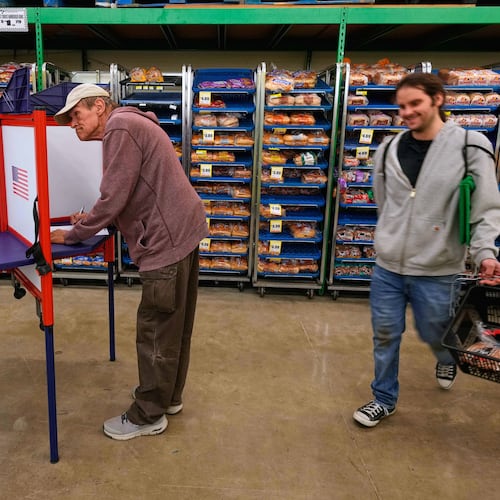Credit: Mike Luckovich
Credit: Mike Luckovich
Toward the end of summer, we asked Atlanta Journal-Constitution readers to send us questions about their biggest concerns this election cycle. Dozens of you shared thoughtful queries about immigration — reflecting how top of mind that issue is as we inch closer to Election Day.
In past stories, we answered reader questions about the situation at the southern border, and how border enforcement works — and how it doesn’t work. We also touched on where the Republican and Democratic tickets stand on immigration policy.
But there were plenty more questions that didn’t fit in either of those two buckets, including concerns about the cost of illegal immigration and comments about undocumented workers’ role in key Georgia industries.
Here are some of those answers.
How much state taxpayer money has been spent on illegal immigration in the entire state of Georgia since 2021? Include pre-K to 16 schooling, medical, welfare, housing, increased policing, and any other factors attributed to illegal immigration. — from Ron Weaver
A caveat: Whether immigration has a net positive or negative impact on the economy and on government budgets is a much-debated issue. The answer is nuanced and I don’t have a specific dollar amount on how much money has been spent or saved. But here’s what I’ve found.
For objective insights, I turned to the Congressional Budget Office (CBO), a nonpartisan agency that provides economic forecasts and estimates the cost of legislative proposals. In July, they came out with a new report that looks at the recent surge of immigration in the U.S., which is driven in significant part by the arrival of unauthorized immigrants at the border. They found that these new immigrants will help reduce the federal deficit by almost $900 billion cumulatively over the next 10 years, because they’ll pay taxes, stimulate the economy and create jobs through spending on goods and services.
Unauthorized immigrants pay property and sales taxes. They use Individual Taxpayer Identification numbers to pay income taxes (and federal payroll taxes are taken from their wages just as they are from everyone else).
But immigration impacts local and state budgets more than the federal budget, because of the kind of services provided by each level of government. In general, state and local governments are responsible for providing the public services available to all residents regardless of immigration status, including services related to education, law enforcement, and health care.
“Research has generally found that increases in immigration raise state and local governments’ costs more than their revenues, and CBO expects that finding to hold in the case of the current immigration surge,” the CBO report says.
The extent to which each state or local government budget is burdened by unauthorized migration depends on the size of its unauthorized population, and how inclusive its public programs are. For example, New York City spent billions between 2022 and 2024 to accommodate newcomers from the border, partly because of local ‘right to shelter’ rules that required city government to provide shelter to anyone who asked for it.
Nationwide, half the states offer in-state tuition at public colleges to unauthorized immigrant students. Those are not policies we see in Georgia, where state law prohibits residents who lack legal status to receive public benefits.
An estimated 339,000 undocumented immigrants call Georgia home. Just six states have larger undocumented populations.
How will climate change impact immigration to Georgia? — from Sara
It’s tough to speak about Georgia specifically, but we do know that climate change has played a role in the surging levels of Central American migration to the U.S. over the last decade.
In the highlands of Guatemala, for instance, more and more of the subsistence farmers who live in the region have been experiencing worsening droughts, pushing them to emigrate. In a report released in 2021, the White House found that tens of millions of people are likely to be displaced worldwide over the next two or three decades “due in large measure to climate change impacts.” Latin America, South Asia and sub-Saharan Africa are among the regions most vulnerable to the effects of climate change.
U.S. immigration policy tends to hinge on deterrence, or toughening rules at the border to dissuade would-be migrants from attempting to come in the first place. But if people can’t feed their families back home because of persistent crop failures, they might still be inclined to make the journey, regardless of the obstacles the U.S. might try to put up.
How many undocumented workers are employed by the dangerous poultry processing plants? Are there consequences when the plants fail to verify their employees? — from Emilie
Meatpacking, one of the most hazardous industries in the country, is reliant on the labor of foreign-born individuals, both documented and undocumented. Poultry processing is no exception.
In Georgia, Gainesville is well-known as the hub of the state’s nation-leading poultry industry. Local leaders estimate that roughly 80% of the city’s immigrant population work in poultry plants, or polleras. Many are living and working in the state without authorization. According to a 2019 report from the Pew Research Center, 65% of Gainesville’s foreign-born population lacked legal status as of 2016 — the highest proportion of all U.S. metro areas.
Georgia law requires all but the smallest private employers to use a federal work authorization program, called E-Verify, to ensure all new hires are living in the country legally. Local labor advocates tell me that a common workaround employers use is to bring on employees through third party staffing agencies or labor contractors. This gives them some measure of plausible deniability (and legal protection), should it come to light that the people working in their facilities are unauthorized immigrants.
What is the estimated percentage of unauthorized workers currently employed on Georgia farms compared to those with official H-2A visas, and why are there such problems with Georgia farmers being able to access a reliable immigrant workforce? — from Crystal
Regarding the role of undocumented immigrants in farming, here’s what we know: Nationwide, about 40% of all farm workers lack legal immigration status, according to data from the U.S. Department of Agriculture. In Georgia, as in other parts of the country, that number has presumably gone down as more and more immigrants come to work via the H-2A program, which allows farmers to legally bring in foreign-born workers for a period of up to 10 months.
In 2023, more than 37,500 H-2A workers came to Georgia, making the state one of the top users of the program nationwide, up from roughly 5,800 in 2012. Employers are supposed to only turn to the H-2A program when they are unable to find domestic workers. Doing so comes with significant costs, since farmers must provide housing to H-2A workers, alongside other obligations.
As this seems to be a huge issue in the U.S., I was wondering if you could give us some perspective as to how other Western European countries, specifically France, UK and Germany deal with this issue. Canada as our neighbor would also be an interesting area to hear about. — from David Bybee
Western European countries, including the ones mentioned in your question, have recently made headlines over more restrictive rhetoric and policies around immigration, putting them on par with the U.S.
Our neighbor to the north presents an interesting contrast. It’s significantly easier to immigrate legally there than it is to immigrate legally to this country, where pathways to work visas are much narrower and time consuming.
Take for instance Canada’s Express Entry system, which allows people who are already in Canada, such as international students or people who arrived via a temporary visa, to apply for permanent residence (the system gives preference to younger candidates with high levels of education, language skills, and job offers). Most applicants receive a decision within six months.
Easy-to-navigate pathways like Express Entry exist because Canada’s political leaders have a stated goal to bring people in. They see immigration as a way to fill labor shortages, grow the economy, and address a declining birth rate. Although public opinion has started to change, Canadians generally continue to view both immigrants and their nation’s immigration system in a more positive light compared with people in this country.
About the Author
Keep Reading
The Latest
Featured



